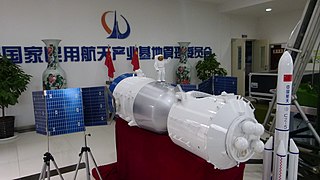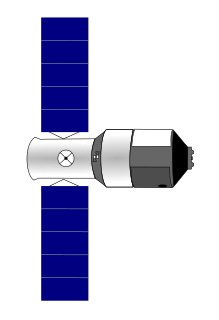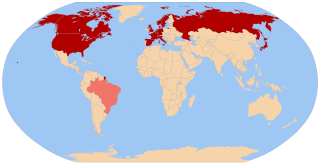
A space station, also known as an orbital station or an orbital space station, is a spacecraft capable of supporting a human crew in orbit for an extended period of time, and is therefore a type of space habitat. It lacks major propulsion or landing systems. Stations must have docking ports to allow other spacecraft to dock to transfer crew and supplies.

The Soyuz programme is a human spaceflight programme initiated by the Soviet Union in the early 1960s. The Soyuz spacecraft was originally part of a Moon landing project intended to put a Soviet cosmonaut on the Moon. It was the third Soviet human spaceflight programme after the Vostok and Voskhod programmes.

The NASA Deep Space Network (DSN) is a worldwide network of American spacecraft communication ground segment facilities, located in the United States (California), Spain (Madrid), and Australia (Canberra), that supports NASA's interplanetary spacecraft missions. It also performs radio and radar astronomy observations for the exploration of the Solar System and the universe, and supports selected Earth-orbiting missions. DSN is part of the NASA Jet Propulsion Laboratory (JPL).
The space program of the People's Republic of China is directed by the China National Space Administration (CNSA). Its technological roots can be traced back to the late 1950s, when China began a ballistic missile program in response to perceived American threats. However, the first Chinese crewed space program only began several decades later, when an accelerated program of technological development culminated in Yang Liwei's successful 2003 flight aboard Shenzhou 5. This achievement made China the third country to independently send humans into space. Plans currently include a permanent Chinese space station by the end of 2022, crewed expeditions to the Moon and interplanetary missions to explore the Solar System and beyond.

Shenzhou 6 was the second human spaceflight of the Chinese space program, launched on October 12, 2005 on a Long March 2F rocket from the Jiuquan Satellite Launch Center. The Shenzhou spacecraft carried a crew of Fèi Jùnlóng (费俊龙) and Niè Hǎishèng (聂海胜) for five days in low Earth orbit. It launched three days before the second anniversary of China's first human spaceflight, Shenzhou 5.
Shenzhou 1 launched on 19 November 1999, was the first uncrewed launch of the Shenzhou spacecraft. The spacecraft used was not equipped with a life support system or an emergency escape system. After orbiting the Earth 14 times, the command for retrofire was sent by the Yuan Wang 3 tracking ship off the coast of Namibia at 18:49 UTC. After a successful reentry it landed about 415 kilometres (258 mi) east of its launch pad and 110 kilometres (68 mi) north-west of Wuhai, Inner Mongolia.

Shenzhou 7 was the third human spaceflight mission of the Chinese space program. The mission, which included the first Chinese extra-vehicular activity (EVA) carried out by crew members Zhai Zhigang and Liu Boming, marked the commencement of the second phase of the Chinese government's Project 921.

Jing Haipeng is a major general of the People's Liberation Army Ground Force (PLAGF) in active service as a vice-commander of the 82nd Group Army. A fighter pilot in the PLA Air Force (PLAAF), he was selected to be a PLA Astronaut Corps (PLAAC) astronaut in 1998. He is the first Chinese astronaut to have flown on three missions.

Tiangong is China's program to create a modular space station, comparable to Mir. This program is independent and unconnected to any other international space-active countries. The program is part of the China Manned Space Program began in 1992. The core module, the Tianhe was finally launched on 29 April 2021 marking the start of the Tiangong Space program deployment.

Tiangong, officially the Tiangong space station, is a space station being constructed by China in low Earth orbit between 340 and 450 km above the surface. Being China's first long-term space station, it is the goal of the "Third Step" of the China Manned Space Program. Once completed, the Tiangong Space Station will have a mass between 80 and 100 t, roughly one-fifth the mass of the International Space Station and about the size of the decommissioned Russian Mir space station.

Shenzhou 9 was the fourth crewed spacecraft flight of China's Shenzhou program, launched at 18:37:24 CST, 16 June 2012. Shenzhou 9 was the second spacecraft and first crewed spacecraft to dock with the Tiangong-1 space station, which took place on 18 June. The Shenzhou 9 spacecraft landed at 10:01:16 CST on 29 June in the Inner Mongolia Autonomous Region. The mission's crew included the first Chinese female astronaut, Liu Yang. The next mission was Shenzhou 10, which launched on 11 June 2013.

Shenzhou 10 was a crewed spaceflight of China's Shenzhou program that was launched on 11 June 2013. It was China's fifth crewed space mission. The mission had a crew of three astronauts: Nie Haisheng, who was mission commander and previously flew on Shenzhou 6; Zhang Xiaoguang, a former PLAAF squadron commander who conducted the rendezvous and docking; and Wang Yaping, the second Chinese female astronaut. The Shenzhou spacecraft docked with the Tiangong-1 trial space laboratory module on 13 June, and the astronauts performed physical, technological, and scientific experiments while on board. Shenzhou 10 was the final mission to Tiangong-1 in this portion of the Tiangong program. On 26 June 2013, after a series of successful docking tests, Shenzhou 10 returned to Earth.

The China Manned Space Program, also known as Project 921, is a space program developed by China and run by the China Manned Space Agency (CMSA), designed to develop and enhance human spaceflight capabilities for China. It was approved on 21 September 1992 and been in operation ever since.
Tianlian I, also known as Tian Lian 1, TL-1, and CTDRS-1 is a Chinese data tracking and relay communications satellite series. Based on the DFH-3 satellite bus, Tianlian I provides communications coverage for crewed Shenzhou missions, from Shenzhou 7 onwards, and the Tiangong space station. Functionally, it is similar to the United States Tracking and Data Relay Satellite System.

Tiangong-1 was China's first prototype space station. It orbited Earth from September 2011 to April 2018, serving as both a crewed laboratory and an experimental testbed to demonstrate orbital rendezvous and docking capabilities during its two years of active operational life.

Tiangong-2 was a Chinese space laboratory and part of the Project 921-2 space station program. Tiangong-2 was launched on 15 September 2016. It was deorbited as planned on 19 July 2019.

Wang Yaping is a Chinese military transport pilot and taikonaut. Wang was the second female taikonaut selected to the People's Liberation Army Astronaut Corps, the second Chinese woman in space, and the first Chinese woman to perform a spacewalk.

Tianhe, officially the Tianhe core module, is the first module to launch of the Tiangong space station. It was launched into orbit on 29 April 2021, as the first launch of the final phase of Tiangong program, part of the China Manned Space Program.

Politics of the International Space Station have been affected by superpower rivalries, international treaties and funding arrangements. The Cold War was an early factor, overtaken in recent years by United States distrust of China. The station has an international crew, with the use of their time, and that of equipment on the station, being governed by treaties between participant nations.














